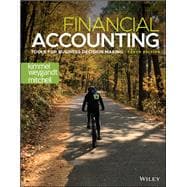Financial Accounting: Tools for Business Decision Making by Paul Kimmel, Jerry Weygandt, and Jill Mitchell provides a practical introduction to financial accounting with a focus on how to use accounting information to make business decisions. Through significant course updates, the 10th Edition presents an active, hands-on approach to spark efficient and effective learning and develops the necessary skills to inspire and prepare students to be the accounting and business professionals of tomorrow.
To ensure maximum understanding, students work through integrated assessment at different levels of difficulty right at the point of learning. The course's varied assessment also presents homework and assessment within real-world contexts to help students understand the why and the how of accounting information and business application.
Throughout the course, students also work through various hands-on activities including Cookie Creations Cases, Expand Your Critical Thinking Questions, Excel Templates, and Analytics in Action problems, all within the accounting context. These applications all map to chapter material, making it easier for instructors to determine where and how to incorporate key skill development in their syllabus.
With Financial Accounting, students will understand the foundations of financial accounting and develop the necessary tools for business decision-making, no matter what path they take.









